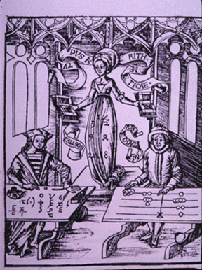 WEMSK7:
Arithmetic & Numerology
WEMSK7:
Arithmetic & Numerology
This is another sticky wicket. We are still lacking a decent study
on the way numbers were handled in the Middle Ages. One important
thing to remember is that modern arithmetic is unlike medieval
arithmetic. We have Arabic numbers, they had for the most part
Roman. For most of the Middle Ages, arithmetic was just counting.
The ease with which we multiply and divide was unknown to them, and
much was done by iteration. We have regular numbers and square
numbers; they had triangular, pentagonal, stellate, etc. (see
Hogben under Geometry). They believed in Wisdom 11.21: omnia
in
mensura et numero et pondere disposuisti `thou hast ordered all
things in measure, and number, and weight', so numbers had
significance as well as being numbers. Much of the arithmetic
was
for the purpose of calendar calculation. BTW, remember the
etymology of calculus. They did use counting boxes and the like.
1. A good start on elementary arithmetic is: Gottfried Friedlein,
Die Zahlzeichen und das elementare Rechnen der Griechen und Roemern
und des christlichen Abendlandes vom 7. bis 13. Jh. (Wiesbaden:
Saendig, 1968; repr. of 1869 ed.).
2. Computus. The medieval computus was for the most part devoted
to the calculation of the church year, time, cycles and the like;
see the section on the Calendar.
a. Bedae Opera de temporibus, ed. Charles W. Jones (Cambridge:
Mediaeval Academy of America, 1943). This would be the best place
to start. There are English translations, e.g. Bede, the Reckoning
of Time, tr. with intro., notes and commentary, by Faith Wallis.
Translated Texts for Historians 29 (Liverpool: Liverpool UPress,
1999).
b. Just added for our Old English friends: Heinrich Henel, Studien
zum altenglischen Computus. Beitraege zur englischen Philologie,
Heft 26 (Leipzig: Tauchnitz, 1934). Mostly devoted to Byrhtferth.
3. As we moved away from counting and into `real' arithmetic, a
number of texts on `algorismus' arose. A good survey is offered
by:
a. The Earliest arithmetics in English, ed. with introduction by
Robert Steele. EETS, Extra Series, 118 (London, Published for the
Early English Text Society: Oxford University Press, 1922.
Reprinted, (New York: Kraus, 1973). Contains: The crafte of
nombrynge, a translation and amplification of one of the glosses on
the De algorismo of Alexander de Villa Dei (Egerton ms. 2622)- The
art of nombryng, a translation of John of Holywood's De arte
numerandi (Ashmole ms. 396, fol. 48) - Accomptynge by counters,
reprinted from the 1543 edition of Robert Record's Arithmetic,
printed by R. Wolfe.- Appendix I. A treatise on the numeration of
algorism (From a 14th century ms.) II. Carmen de algorismo, by
Alexander de Villa Dei (B.M. ms., 8 C IV., with additions from
12 E. 1 & Eg. 2622)
4. Numbers were, as we have said, symbolic, and they were used in
the construction of everything:
a. Michael J. Batts, "Numerical Structure in Medieval Literature,"
in Formal Aspects of Medieval German Poetry: A Symposium, ed.
Stanley N. Werbow (Austin, TX: UTexasP, 1969), 93-121. A fair
survey, with bibliography. Easily supplemented by MLA.
b. Robert E. McNally, S. J., "Der irische Liber de numeris. Eine
Quellenanalyse des pseudo-isidorischen Liber de numeris" (Diss.
Munich, 1957). An excellent source study. An outline is found in
the Medtextl archives.
c. For symbolic numbers in general, a good read: Karl Menninger,
Number Words and Number Symbols. A Cultural History of Numbers, tr.
Paul Broneer (Cambridge: MITPress, 1969). Translation of his
revised ed., Zahlwort & Ziffer (Goettingen: Vandenhoeck & Ruprecht,
1958.
d. For a great list of medieval examples: Hieronymus Lauretus,
Silva allegoriarum totius sacrae scripturae (Barcelona, 1570),
photomechanical reprint of the 10th ed. (Cologne, 1681) (Munich:
Fink, 1971).
e. Heinz Meyer & Rudolph Suntrup, Lexikon der mittelalterliche
Zahlenbedeutung. Muenstersche Mittelalter-Schriften (Munich: Fink,
1987). A good survey with bibliographies.
5. It is good to look at times at the literatures on the edge, for
they often have collected better than the center:
a. Alfraedhi islenzk, ed. Kr. Kaalund. Samfund til udgivelse af
gammal nordisk Litteratur (Copenhagen: S. L. Mo/ller, 1917-18). A
good survey of just about everything symbolic. The Cisiojanus is
illustrated. We ought to have a bibliography on the hand and
all
the things we can do with it. An outline of the Alfraedhi is found
in the medtextl archives.